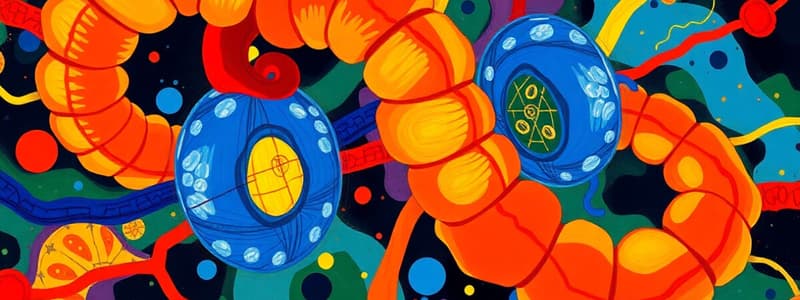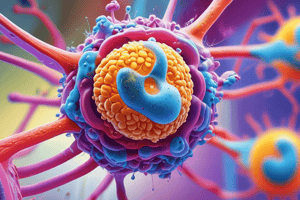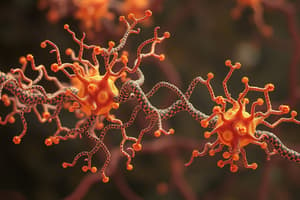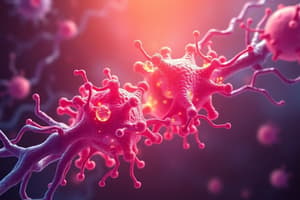Podcast
Questions and Answers
What role do membrane proteins play in relation to the hydrophobic core of biomembranes?
What role do membrane proteins play in relation to the hydrophobic core of biomembranes?
- They facilitate transport of specific molecules across the membrane. (correct)
- They create a barrier to all solutes.
- They strengthen the hydrophobic core through chemical reactions.
- They change the hydrophobic nature of the membrane.
Which type of signaling involves signaling molecules that affect target cells in close proximity?
Which type of signaling involves signaling molecules that affect target cells in close proximity?
- Endocrine signaling
- Autocrine signaling
- Paracrine signaling (correct)
- Juxtacrine signaling
Which of the following best describes the first step of extracellular signaling?
Which of the following best describes the first step of extracellular signaling?
- Binding of signal by a receptor.
- Transport of signaling molecule to target cell.
- Specific changes in cellular function.
- Synthesis of signaling molecule. (correct)
What is the function of second messengers in signal transduction pathways?
What is the function of second messengers in signal transduction pathways?
What is an example of a signaling molecule that can act both as a neurotransmitter and a systemic hormone?
What is an example of a signaling molecule that can act both as a neurotransmitter and a systemic hormone?
What is typically the first response in a signaling pathway initiated by a hydrophilic chemical signal?
What is typically the first response in a signaling pathway initiated by a hydrophilic chemical signal?
In which type of signaling do cells respond to substances that they themselves release?
In which type of signaling do cells respond to substances that they themselves release?
What facilitates the specific changes in cellular function, metabolism, or development following signal transduction?
What facilitates the specific changes in cellular function, metabolism, or development following signal transduction?
What is the primary role of PDZ domains in cytosolic proteins?
What is the primary role of PDZ domains in cytosolic proteins?
Which characteristic describes GTP-binding switch proteins?
Which characteristic describes GTP-binding switch proteins?
How do SH3 domains interact with proteins?
How do SH3 domains interact with proteins?
What are the typical structural features of most cell surface receptors mentioned?
What are the typical structural features of most cell surface receptors mentioned?
Which statement accurately describes the role of actin filaments in membrane protein clustering?
Which statement accurately describes the role of actin filaments in membrane protein clustering?
What initiates the activation of GTP-binding proteins?
What initiates the activation of GTP-binding proteins?
In the context of intracellular signaling, what role do protein kinases play?
In the context of intracellular signaling, what role do protein kinases play?
What is the effect when GTP is hydrolyzed to GDP in GTP-binding proteins?
What is the effect when GTP is hydrolyzed to GDP in GTP-binding proteins?
What is the main function of protein kinases?
What is the main function of protein kinases?
Which second messenger is responsible for activating protein kinase A?
Which second messenger is responsible for activating protein kinase A?
What role does Ca2+ play in cellular responses?
What role does Ca2+ play in cellular responses?
Which of the following is NOT an element of the G Protein Coupled Receptor system?
Which of the following is NOT an element of the G Protein Coupled Receptor system?
What is one of the short-term effects of GPCR activation in cells?
What is one of the short-term effects of GPCR activation in cells?
What is the primary function of glucose-6 phosphate in muscle cells?
What is the primary function of glucose-6 phosphate in muscle cells?
Which enzyme is responsible for reversing the effects of PKA in glycogen metabolism?
Which enzyme is responsible for reversing the effects of PKA in glycogen metabolism?
How does PKA enhance glycogen metabolism directly?
How does PKA enhance glycogen metabolism directly?
What is produced when PIP2 is cleaved by phospholipase C?
What is produced when PIP2 is cleaved by phospholipase C?
What happens to calcium ions (Ca2+) as a result of IP3 binding to its receptor?
What happens to calcium ions (Ca2+) as a result of IP3 binding to its receptor?
Epinephrine removal leads to a drop in which molecule, affecting PKA activity?
Epinephrine removal leads to a drop in which molecule, affecting PKA activity?
What type of signaling does activation of GPCRs typically amplify?
What type of signaling does activation of GPCRs typically amplify?
What role does DAG play in the IP3/DAG signaling pathway?
What role does DAG play in the IP3/DAG signaling pathway?
What is the primary function of Gα subunit in trimeric G proteins?
What is the primary function of Gα subunit in trimeric G proteins?
Which of the following GPCRs is coupled to an inhibitory G protein?
Which of the following GPCRs is coupled to an inhibitory G protein?
What role does adenylyl cyclase play in cellular signaling?
What role does adenylyl cyclase play in cellular signaling?
How does binding of a ligand to GPCRs affect G proteins?
How does binding of a ligand to GPCRs affect G proteins?
Which of the following describes a primary consequence of Gβγ subunit activation?
Which of the following describes a primary consequence of Gβγ subunit activation?
What is the function of Protein Kinase A (PKA) in cellular signaling?
What is the function of Protein Kinase A (PKA) in cellular signaling?
Which type of GPCR is primarily responsible for increasing the levels of cAMP?
Which type of GPCR is primarily responsible for increasing the levels of cAMP?
What is the overall effect of epinephrine on glycogen metabolism?
What is the overall effect of epinephrine on glycogen metabolism?
Which structure of GPCRs is critical for their function?
Which structure of GPCRs is critical for their function?
Which of the following describes the role of second messengers in GPCR signaling?
Which of the following describes the role of second messengers in GPCR signaling?
What occurs when acetylcholine binds to the cardiac muscarinic receptors?
What occurs when acetylcholine binds to the cardiac muscarinic receptors?
How does the activity of G proteins get terminated?
How does the activity of G proteins get terminated?
Which structure in the cell is primarily targeted by G protein signaling pathways?
Which structure in the cell is primarily targeted by G protein signaling pathways?
Flashcards
GPCR
GPCR
A cell surface receptor involved in various cellular processes, detecting signals like hormones and light.
7 transmembrane α-helices
7 transmembrane α-helices
GPCR structural characteristic; protein spans the membrane 7 times.
Trimeric G protein
Trimeric G protein
Protein with 3 subunits (α, β, γ) involved in signal transduction.
α subunit
α subunit
Signup and view all the flashcards
βγ subunit
βγ subunit
Signup and view all the flashcards
GPCR activation
GPCR activation
Signup and view all the flashcards
Signal transduction
Signal transduction
Signup and view all the flashcards
Second messenger
Second messenger
Signup and view all the flashcards
cAMP
cAMP
Signup and view all the flashcards
IP3
IP3
Signup and view all the flashcards
DAG
DAG
Signup and view all the flashcards
Glycogen
Glycogen
Signup and view all the flashcards
Glycogen synthase
Glycogen synthase
Signup and view all the flashcards
Glycogen phosphorylase
Glycogen phosphorylase
Signup and view all the flashcards
Epinephrine
Epinephrine
Signup and view all the flashcards
Protein kinase A (PKA)
Protein kinase A (PKA)
Signup and view all the flashcards
Protein Kinase C (PKC)
Protein Kinase C (PKC)
Signup and view all the flashcards
Study Notes
G Protein Coupled Receptors (GPCR)
- A large family of cell surface receptors that are involved in a wide range of cellular processes.
- They are responsible for detecting a variety of extracellular signals, including hormones, neurotransmitters, light, and odorants.
- GPCRs are characterized by their seven transmembrane α-helical domains.
- The N-terminus of the protein is located on the exoplasmic face of the membrane, and the C-terminus is located on the cytosolic face.
- The C3 and C4 domains interact with trimeric G proteins on the cytosolic side of the membrane.
Trimeric G Proteins
- Composed of three subunits: α, β, and γ.
- The β and γ subunits remain associated and are referred to as the βγ subunit.
- The α subunit is a GTPase switch protein that can be in an active (GTP-bound) or inactive (GDP-bound) state.
GPCR Signaling Pathways
- When a ligand binds to a GPCR, it activates the associated trimeric G protein.
- This activation involves the exchange of GDP for GTP on the α subunit of the G protein, causing it to dissociate from the βγ subunit.
- The activated α subunit (α-GTP) or the βγ subunit can interact with downstream effector proteins.
- These effector proteins are either membrane-bound ion channels or enzymes that catalyze the production of second messengers.
Examples of GPCR Signaling Pathways
-
Muscarinic Acetylcholine Receptors in Heart Muscle:
- Acetylcholine binding to muscarinic receptors in the heart is inhibitory, mediated by a Gi protein.
- This leads to the opening of K+ channels, hyperpolarization of the cell, and a decrease in the heart rate.
-
β-Adrenergic Receptors:
- Couple to the stimulatory Gs protein.
- Activate adenylyl cyclase and increase cAMP levels.
-
α-Adrenergic Receptors:
- Couple to the inhibitory Gi protein.
- Inactivate adenylyl cyclase and decrease cAMP levels.
Second Messengers in GPCR Signaling
-
cAMP: A cyclic nucleotide second messenger that activates protein kinase A (PKA).
-
IP3 (inositol triphosphate) and DAG (diacylglycerol):
- IP3 causes the release of Ca2+ from the endoplasmic reticulum (ER).
- DAG, a lipid-soluble molecule, activates protein kinase C (PKC) in the plasma membrane.
GPCRs and Metabolism
- Epinephrine:
- A hormone that plays a role in the body's response to stress.
- Activates different types of GPCRs to regulate glycogen metabolism.
- Binding of epinephrine to β-adrenergic receptors triggers the breakdown of glycogen into glucose.
Glycogen Metabolism
- Glycogen: A large glucose polymer stored in the liver and muscle.
- Glycogen synthase: An enzyme that builds glycogen.
- Glycogen phosphorylase: An enzyme that breaks down glycogen.
Regulation of Glycogen Metabolism
- PKA plays a crucial role in regulating glycogen metabolism by phosphorylating and activating glycogen phosphorylase kinase (GPK) and inactivating glycogen synthase.
- cAMP levels are critical for regulating PKA activity.
Signal Amplification
- GPCR signaling pathways exhibit signal amplification.
- One activated GPCR can trigger the activation of a cascade of downstream proteins, resulting in a significant amplification of the initial signal.
Key Concepts
- Signal transduction: The process by which cells receive and respond to signals from their environment.
- Second messengers: Small intracellular molecules that relay signals from cell surface receptors to downstream effectors.
- Protein kinases: Enzymes that add phosphate groups to proteins.
- Protein phosphatases: Enzymes that remove phosphate groups from proteins.
- GTPases: Switch proteins that are active when GTP-bound and inactive when GDP-bound.
- Effector proteins: Proteins that mediate the cellular response to a signal.
Studying That Suits You
Use AI to generate personalized quizzes and flashcards to suit your learning preferences.




